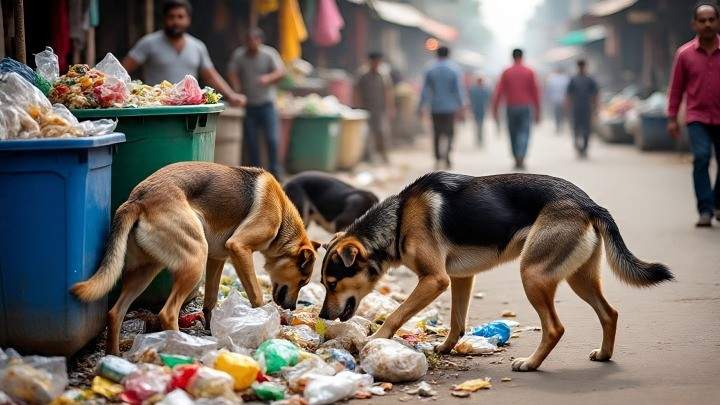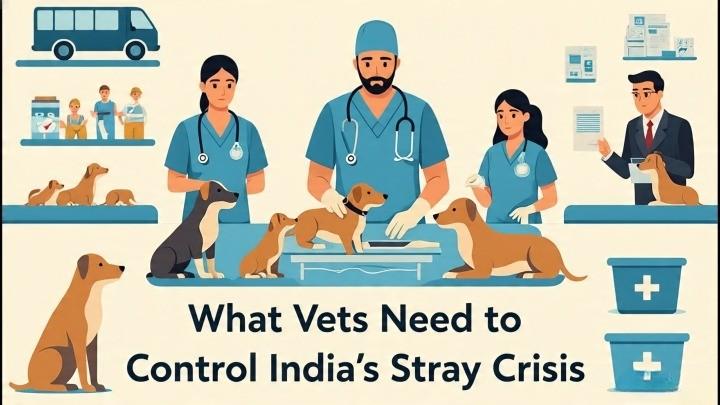
On August 11, 2025, Delhi-NCR’s Supreme Court directed all stray dogs to be transferred to permanent shelters within eight weeks, and prohibited the release of strays after sterilization until there was a resolution of over 1.5 lakh dog bite instances in 2024. The new bench is now hearing various petitions to stay the order, in light of the ongoing debate.
Shelters, though, are not really the solution. Shelters are a short-term solution to an ongoing problem. The nature of shelters creates overcrowding and utilizes limited resources. The move to transfer strays raises issues of humane treatment for stray dogs. The crisis calls for more sustainable solutions that allow for human safety without completely confined treatment of stray dogs.
Table of Contents
Understanding the Stray Dog Problem in India – A Heartfelt Explanation

Millions of stray dogs live among the streets of India- some of them are loved, some are feared, and many of them are just trying to survive. The strays search for food, shelter, and kindness, but there are too many now, and it is a heartbreaking crisis. Some people see them as companions and best friends, others see them as a threat. The reality is, behind every set of sad eyes, is a tale of neglect, survival, and in some cases, utter tragedy.
How Big Is The Stray Dog Population India
Stray dog population in India based on the Livestock Census (2012 vs 2019). The latest official census (2025) is not published yet.
| State/UT | 2012 Stray Dogs | 2019 Stray Dogs | Absolute Change |
|---|---|---|---|
| Uttar Pradesh | 4,179,245 | 2,059,261 | –2,119,984 |
| Odisha | 862,520 | 1,734,399 | +871,879 |
| Maharashtra | 1,216,093 | 1,276,399 | +60,306 |
| Rajasthan | 1,151,015 | 1,275,596 | +124,581 |
| Madhya Pradesh | 1,208,539 | 1,009,076 | –199,463 |
| West Bengal | 1,157,170 | 1,140,165 | –17,005 |
| Karnataka | 876,081 | 1,141,173 | +265,092 |
| Andhra Pradesh (incl. Telangana) | 1,237,988 | 864,816 | –373,172 |
| Bihar | 1,037,720 | 696,142 | –341,578 |
| Gujarat | 846,093 | 931,170 | +85,077 |
| Assam | 516,499 | 213,898 | –302,601 |
| Tamil Nadu | 647,798 | 441,208 | –206,590 |
| Jharkhand | 338,617 | 436,260 | +97,643 |
| Haryana | 422,474 | 464,578 | +42,104 |
| Punjab | 305,482 | 290,624 | –14,858 |
| Chhattisgarh | 343,622 | 394,686 | +51,064 |
| Kerala | 268,994 | 289,986 | +20,992 |
| Jammu & Kashmir | 270,577 | 308,897 | +38,320 |
| Delhi | 60,472 | 60,472 | 0 |
| Uttarakhand | 47,985 | 84,459 | +36,474 |
| Himachal Pradesh | 65,220 | 76,933 | +11,713 |
| Arunachal Pradesh | 4,644 | 11,383 | +6,739 |
| Meghalaya | 5,350 | 10,653 | +5,303 |
| Tripura | 10,195 | 17,078 | +6,883 |
| Goa | 16,325 | 27,864 | +11,539 |
| Sikkim | 8,703 | 10,695 | +1,992 |
| Puducherry | 17,676 | 19,687 | +2,011 |
| Chandigarh | 7,928 | 12,922 | +4,994 |
| Andaman & Nicobar Islands | 8,167 | 5,300 | –2,867 |
| Daman & Diu | 1,134 | 3,164 | +2,030 |
| Dadra & Nagar Haveli | 2,173 | 0 | –2,173 |
| Manipur | 23 | 0 | –23 |
| Nagaland | 7 | 342 | +335 |
| Mizoram | 0 | 69 | +69 |
| Lakshadweep | 0 | 0 | 0 |
Reasons Of These Out of Control Numbers ?
The stray dog crisis in India has not happened overnight. There are many scientific and socio-environmental factors that have allowed dog populations to grow without restraint.
1. High Reproductive Rate (Exponential Breeding)

- Dogs breed twice a year and have 4-6 puppies each time.
- One female dog, without sterilization, can give birth to more than 70 puppies in her reproductive lifetime, leaving room for an exponential rise.
2. Lack of Effective Sterilization (ABC Program Failures)
- Animal Birth Control (ABC) programs are underfunded and inconsistent.
- Only 30-40% of ferals are neutered, meaning that there is a constant rate of breeding.
3. Abundant Food Supply (and Poor Waste Handling)

- The open and easily accessible garbage, slaughter waste and street food provide food sources throughout the year.
- The public is aiding strays adapting and thriving near landfills and meat markets, which means feral populations have increased.
4. Urbanization & Encroachment of Territories
- Rapid construction destroys natural dog territories, pushing them into cities.
- Strays adapt to human settlements due to shelter and food availability.
5. Dumping of Unwanted Pets
- Irresponsible pet ownership leads to abandoned dogs that breed on streets.
- A large number of today’s strays were once loved pets or loyal guard dogs, sadly abandoned or left behind by their owners
6. Lack of Predators & Natural Population Control
- Unlike forests, cities have no natural predators (like wolves or big cats) to control dog numbers.
- Human interference disrupts natural ecological checks.
7. Religious & Cultural Feeding Practices
- Many feed strays as a religious duty or goodwill gesture, but without sterilization, this supports overpopulation.
- Unregulated feeding helps to sustain more dogs than the ecosystem can handle.
8. Low Vaccination Rates (Rabies & Disease Spread)
- Only 30% of strays( approx.) are vaccinated against rabies, allowing diseases to spread.
- Sick dogs are often avoided instead of treated, increasing uncontrolled breeding.
9. Climate & Survival Adaptability
- Stray dogs are highly adaptable to heat, monsoons, and urban stress.
- Unlike other animals, they thrive in human-dominated spaces, ensuring survival.
10. Weak Policy Enforcement & Legal Gaps
- Laws on pet ownership & stray control are poorly enforced.
- Municipalities lack funds, manpower, and systematic plans for population control.
The Result? A Never-Ending Cycle
These factors create a feedback loop: more strays → more breeding → more conflicts → more fear → less effective control. Scientific, humane, and policy-driven solutions are needed to break this cycle.
Human–Animal Conflict: Rising Dog Bite Cases In India And Rabies Deaths

| Category | Statistics (Approx.) | Key Insights |
|---|---|---|
| Daily Dog Bite Cases | ~10,000 bites/day (≈3.6 million annually) | India records one of the highest dog bite incidents in the world. |
| Annual Dog Bite Cases | 3.6–4.2 million cases/year | Many cases go unreported, especially in rural areas. |
| Rabies Deaths (Annual) | ~20,000 deaths/year | India contributes to ~36% of global rabies deaths. |
| Global Burden Comparison | Worldwide ≈ 59,000 deaths/year | India alone accounts for 1 in 3 rabies deaths globally. |
| Age Group Most Affected | Children under 15 years (≈40% of bite victims) | Children are more vulnerable due to close contact with dogs and lack of awareness. |
| Urban vs Rural Divide | >80% rabies deaths in rural areas | Poor vaccine access and late treatment worsen rural outcomes. |
| Animal Responsible | Dogs (91% of cases); Cats (3–4%), Monkeys (2–3%), Others | Dogs remain the primary rabies vector in India. |
| Vaccine Availability | Post-Exposure Prophylaxis (PEP) available, but shortages common in villages | Lack of timely PEP is a major cause of rabies fatalities. |
| Healthcare Costs | Billions spent annually on dog bite management and rabies vaccines | A major economic and public health burden. |
Key Takeaway:
Dog bites are common but preventable, and rabies is 100% fatal once symptoms appear—yet 100% preventable with timely vaccination. Most tragedies occur due to lack of awareness, delayed treatment, and poor vaccination coverage in rural India.
The Role of Dog Shelters

- Rescue & Rehabilitation – Shelters take in injured, sick, or abandoned dogs, providing medical care and recovery.
- Sterilization & Vaccination – They conduct mass spaying/neutering and anti-rabies drives to control population and disease.
- Temporary Safe Haven – Offer food, shelter, and safety for strays until they find permanent homes.
- Adoption Facilitation – Help match stray and abandoned dogs with loving families, reducing street populations.
- Reducing Human-Dog Conflict – By removing aggressive or suffering strays, shelters lower bite risks and public fear.
- Awareness & Education – Teach responsible pet ownership, sterilization benefits, and humane treatment of strays.
- Euthanasia as Last Resort – Some shelters humanely euthanize terminally ill or dangerous dogs (where no rehabilitation is possible).
- Preventing Overpopulation – By keeping pregnant strays or puppies off streets, they break the breeding cycle.
- Volunteer & Community Engagement – Encourage public involvement in feeding, fostering, and funding stray welfare.
- Legal & Policy Advocacy – Push for stronger animal protection laws and better municipal stray management programs.
Why Shelters Help but Don’t Solve the Core Problem

While shelters play a crucial role in rescuing and rehabilitating stray dogs, they cannot fully address the root causes of India’s overpopulation problem.
1. Limited Capacity vs. Exploding Stray Population
- Shelters can only house a fraction of India’s estimated 60 million strays.
- Even the best-run shelters struggle with space, funding, and manpower, making large-scale impact impossible.
2. High Return-to-Street Rates
- Many dogs escape or are released back due to overcrowding, undoing rehabilitation efforts.
- Without post-release tracking, neutered/vaccinated dogs often return to breeding.
3. Behavioral Challenges in Rehoming
- Street dogs develop survival aggression & anxiety, making adoption difficult.
- Studies show only 10-20% of rescued dogs get adopted; the rest live in shelters indefinitely.
4. Financial & Operational Unsustainability
- Running shelters is expensive (food, medicine, staff). Most rely on donations, leading to inconsistent care.
- No long-term government funding means shelters operate in crisis mode, not prevention.
5. Disease Spread in Congested Shelters
- Overcrowding increases parasitic, viral, and bacterial outbreaks (e.g., distemper, parvovirus).
- Sick dogs require isolation & extra care, straining resources further.
6. Public Apathy & “Not My Problem” Mindset
- Many people dump pets at shelters instead of sterilizing them, worsening the problem.
- Lack of community participation means fewer adoptions & more strays returning to streets.
7. Ineffective ABC (Animal Birth Control) Follow-Up
- Shelters focus on rescues, not street sterilization.
- Without large-scale ABC programs, new litters keep appearing faster than shelters can cope.
8. Ethical Dilemmas: Euthanasia vs. Overpopulation
- No-kill shelters get overcrowded, reducing quality of life.
- Euthanasia-based shelters face public backlash, even when dealing with terminally ill/aggressive dogs.
9. Urban Planning & Garbage Management Failures
- Shelters can’t fix the main cause of strays: open garbage & poor waste disposal.
- Until cities manage waste better, strays will keep thriving outside shelters.
10. Lack of Policy Integration
- Most shelters work independently, with no centralized database or govt-coordinated strategy.
- Without nationwide sterilization, vaccination, and adoption laws, shelters remain a temporary fix.
Uncontrolled Dog Breeding: Lack of Sterilization Programs
Without Animal Birth Control (ABC) and sterilization, street dogs breed rapidly. A female dog can give birth to 2–3 litters per year, and with 6–8 puppies per litter, the population grows expoentially. Failure to sterilize even a small number of dogs can lead to thousands of offspring in a few years.
le Pet Ownership: Abandonment & Neglect
Many pet owners buy pedigree dogs but abandon them when costs rise or when dogs fall sick. Some also allow their unsterilized pets to roam freely, contributing to the stray population. Abandoned pets often breed with strays, worsening the crisis.
Economic Cost: Healthcare Costs Of Dog Bites, Shelter Funding, and Legal Battles

| Category | Cost Factors | Impact (in Simple Words) |
|---|---|---|
| Healthcare (Dog Bites) | – Rabies vaccines & treatment – Wound care & surgeries – Post-exposure prophylaxis (PEP) | – Govt spends ₹500-1000 crores yearly on rabies care. – Poor families suffer high treatment costs. |
| Shelter Operations | – Food, medicine, staff salaries – Infrastructure (kennels, clinics) – Sterilization & vaccination drives | – Running shelters is expensive (₹50,000–₹2 lakh/month per shelter). – Most shelters run on donations, leading to shortages. |
| Legal & Conflict Costs | – Court cases (animal rights vs. public safety) – Compensation for bite victims – Municipal dog control programs | – Long legal battles delay solutions. – Cities spend crores on ABC programs with mixed results. |
| Indirect Economic Loss | – Fear reduces tourism in stray-heavy areas – Productivity loss (workers skipping jobs after bites) – Mental health trauma (especially kids) | – Businesses lose customers in stray-prone zones. – Bite victims face income loss & trauma. |
Why This Matters?
- Money spent on bites & shelters could fund preventive measures (sterilization, waste management).
- Legal fights slow progress—stronger laws could save costs.
- Better policies = Less burden on hospitals & taxpayers.
Alternatives to Shelters: Sustainable Long-Term Solutions

Sterilization and Vaccination Programs for Stray Dogs
Large-scale spay/neuter (ABC program) helps control dog population growth. Vaccination against rabies and other diseases keeps both dogs and humans safe. This is the most effective long-term method worldwide.
Community Feeding with Responsibility: Reducing Aggression in Strays
Feeding dogs in a fixed, clean, and safe spot makes them less aggressive and easier to monitor. Responsible feeders also help report sick or unsterilized dogs for treatment.
Adoption Drives and Foster Care for Dogs in India
Encouraging people to adopt Indian strays instead of buying pedigrees reduces the shelter burden. Foster care gives temporary homes until dogs are adopted, improving their social behavior.
Responsible Pet Ownership in India: Licensing and Vaccination
Pet owners should license, sterilize, and vaccinate their dogs, and avoid abandonment. Stronger rules and awareness ensure pets do not add to the stray population.
Waste Management Reforms: Cutting Off Food Sources for Strays
Stray populations thrive near open garbage dumps. Proper waste segregation, closed bins, and regular disposal reduce stray feeding grounds, naturally lowering dog density in cities.
Partnerships: NGOs, Government, and Communities Working Together
Sustainable success comes when animal welfare NGOs, municipal bodies, vets, and local citizens work together. Shared responsibility ensures better sterilization drives, awareness campaigns, and humane care.Shelters provide only a temporary fix. A mix of sterilization, vaccination, awareness, adoption, waste management, and community participation is the real long-term solution.
Case Studies and Success Stories
Jaipur’s Sterilization Model: A City-Level Success

Jaipur became a global example in humane stray dog population control through its Animal Birth Control (ABC) program, drastically reducing strays and rabies cases. Here’s how it worked:
Key Facts & Achievements
✅ 70% Reduction in Stray Population – From ~60,000 dogs (1990s) to ~18,000 (2020s).
✅ Zero Rabies Deaths Since 2017 – Due to mass vaccination + sterilization.
✅ Recognized by WHO & AWBI – Praised as a model for developing nations.
Scientific Method Behind the Success
1. Large-Scale Sterilization (ABC Program)
- How?
- Dogs caught humanely, sterilized, vaccinated, and released in same area (to prevent territorial voids).
- No killing or permanent shelters—focus on population control, not removal.
- Result?
- Birth rates dropped by over 60% in a decade.
2. Rabies Vaccination Drives
- How?
- Every sterilized dog also got anti-rabies shots.
- Mobile teams tracked strays for booster doses.
- Result?
- Rabies eliminated in dogs & humans.
3. Public-Private Partnership
- How?
- Municipal Corporation + NGOs (like Help in Suffering Trust) jointly ran ABC.
- Govt funded, NGOs executed (efficient & low-cost).
- Result?
- Cost-effective: ₹800-1000 per dog (vs. ₹5000+ in other cities).
4. Community Involvement
- How?
- Locals reported dog clusters, helped in feeding & monitoring.
- No hostility—people saw strays as “community dogs,” not pests.
- Result?
- Less dog-human conflict, higher program acceptance.
5. Data-Driven Monitoring
- How?
- Each dog tagged & GPS-mapped post-surgery to track health & numbers.
- Yearly population surveys to adjust efforts.
- Result?
- No rebreeding, no overpopulation rebound.
Why Other Cities Struggle to Replicate Jaipur?
❌ Lack of Govt-NGO Coordination – Many cities rely only on municipal teams (slow, corrupt).
❌ No Post-Release Tracking – Dogs sterilized but not monitored, leading to new litters.
❌ Public Apathy – People oppose ABC, demand “removal” instead of sterilization.
Lessons from Jaipur’s Model
✔ Sterilization + Vaccination = Best Solution (Not culling or shelters).
✔ Community Support is Key – Educate locals to avoid hostility.
✔ Data with Transparency Matter – Track every dog, measure proper results.
International Stray Dog Solutions: Lessons From Successful Countries

| Country | Method Used | Key Results | Why It Worked? |
|---|---|---|---|
| Netherlands | Strict Laws + Zero Stray Policy | – First zero-stray dog nation (since 2016). | – Mandatory microchipping & sterilization. – Heavy fines for abandonment. – High adoption rates from shelters. |
| Germany | Tierheim (High-Standard Shelters) + Adoption Culture | – 90% adoption rate for shelter dogs. | – Strict pet ownership laws. – No-kill shelters with govt funding. – Public education on adoption. |
| Turkey | Mass Vaccination + Community Care | – Rabies-free since 2020. – Strays seen as “community dogs.” | – Govt-funded feeding & vaccination. – Neutering before release. – Public respect for strays. |
| USA | TNR (Trap-Neuter-Return) + Shelter System | – 50% drop in euthanasia rates (since 2000). | – Strong NGO & municipal coordination. – Foster networks reduce shelter load. – Strict anti-cruelty laws. |
| Bhutan | Nationwide ABC (Animal Birth Control) | – 70% fewer strays in 10 years. | – Govt + Buddhist monks promoted ABC. – Religious compassion reduced hostility. |
Key Takeaways for India:
✔ Strict Laws Work – Penalties for abandonment & mandatory sterilization help.
✔ Community Involvement is Crucial – Public support ensures long-term success.
✔ Shelters Alone Aren’t Enough – ABC + Vaccination + Adoption must combine.
Local NGOs Making an Impact: Best Dog NGOs in India

1. Blue Cross of India (Chennai & Hyderabad)
✅ The oldest & largest animal welfare organization in India (established 1959).
✅ Sterilized 500,000+ dogs via ABC programs.
✅ 24/7 ambulance service (rescues 30,000+ animals yearly).
✅ Disaster rescue ops (Tsunami, Chennai floods).
🔗 Website
2. CUPA (Compassion Unlimited Plus Action) – Bangalore
✅ Handles 500+ rescues/month (accidents, abuse cases).
✅ Runs a trauma center & ICU for critical cases.
✅ Pioneered ABC & anti-rabies drives in Karnataka.
✅ Wildlife + stray dog rescue (holistic approach).
🔗 Website
3. Friendicoes SECA – Delhi
✅ 40+ years of service (shelters 1,200+ animals at a time).
✅ Mobile clinic for street dogs (free treatment & vaccination).
✅ Adoption drives & cruelty investigations.
✅ Works with Delhi Police on animal abuse cases.
🔗 Website
4. People for Animals (PFA) – Nationwide
✅ India’s largest animal rights org (founded by Maneka Gandhi).
✅ 200+ shelters & units across India.
✅Legal Advocacy (advocating against illegal culling, puppy mills).
✅ Wildlife + stray rescue & rehab.
🔗 Website
5. Help in Suffering (HIS) – Jaipur
✅ Architect of Jaipur’s ABC success (70% stray reduction).
✅ WHO-recognized rabies eradication program.
🔗 Website
6. Welfare of Stray Dogs (WSD) – Mumbai
✅ 100,000+ dogs sterilized & vaccinated.
✅ Adoption-focused with community education.
🔗 Website
What Makes These NGOs Stand Out?
✔ Decades of Experience – Proven, large-scale impact.
✔ Multi-City Presence – Nationwide networks.
✔ Innovative Models – ABC, legal advocacy, disaster rescue.
How Can You Support?
- Donate (even ₹500 feeds a stray for a week).
- Volunteer (foster, transport, or manage social media).
- Report Cruelty (NGOs rely on public tips)
Policy and Legal Framework
Current Indian Laws on Stray Dogs and Animal Birth Control

India follows a humane approach to managing stray dogs under the Prevention of Cruelty to Animals Act, 1960 and the ABC (Dogs) Rules, 2001 & 2023. These laws ban killing of stray dogs and instead focus on sterilization and vaccination as the main solution.
Key Laws & Facts
| Law / Rule | Main Provisions | Important Facts |
|---|---|---|
| Prevention of Cruelty to Animals Act, 1960 | Protects animals from unnecessary pain and suffering. | Forms the base law for animal welfare in India. |
| ABC (Dogs) Rules, 2001 | Introduced sterilization + rabies vaccination as the legal way to control stray dog population. | Killing of dogs banned; only sick, incurable dogs can be humanely euthanized. |
| ABC (Dogs) Amendment Rules, 2010 | Strengthened rules for sterilization and monitoring of stray dog populations. | Local bodies made responsible for implementation. |
| ABC (Dogs) Rules, 2023 | Updated rules to improve sterilization, vaccination, and monitoring. | – Mandates animal birth control centers in all states. – Stray dogs must be returned to the same area after sterilization. – Feeding spots for community dogs should be fixed. |
| Supreme Court Rulings (various years) | Upheld that stray dogs cannot be killed; they have the right to live. | Courts directed state governments to strictly follow ABC rules. |
✅ Key Fact:
India is committed to Zero by 30 – eliminating human rabies deaths by 2030 through mass dog vaccination + sterilization.
Gaps in Implementation: Why Laws Exist but Struggles Continue
Even though laws are strong on paper, lack of funds, poor coordination, limited vets, and weak monitoring make real execution very difficult. Many cities sterilize only a small fraction of their stray dogs each year.India needs more funding, stricter rules against abandonment, better waste management, and nationwide vaccination targets. Policies must be humane, but also practical and well-enforced.
Role of Veterinarians in Stray Dogs Population Control

| No. | Role of Veterinarian | How It Helps Reduce Strays |
|---|---|---|
| 1 | Sterilization Surgeries (ABC Programs) | Conducts mass spaying/neutering to prevent uncontrolled breeding. |
| 2 | Rabies & Disease Vaccination | Vaccinates strays to reduce rabies outbreaks, making communities safer and more supportive. |
| 3 | Post-Surgery Care & Monitoring | Ensures dogs recover safely after sterilization, preventing infections or complications. |
| 4 | Training Local ABC Teams | Teaches municipal workers/NGOs proper handling and surgery techniques for scalability. |
| 5 | Public Awareness Campaigns | Educates communities on sterilization benefits, reducing hostility toward ABC programs. |
| 6 | Rescue & Emergency Care | Treats injured/abandoned strays, reducing suffering and uncontrolled litters from unreleased dogs. |
| 7 | Data Collection & Tagging | Tracks sterilized dogs (ear tags/microchips) to avoid duplicate surgeries. |
| 8 | Humane Euthanasia (Last Resort) | Puts terminally ill/aggressive dogs to sleep ethically, preventing further harm. |
| 9 | Policy Advocacy | Advises governments on effective ABC laws and waste management to curb stray proliferation. |
| 10 | Shelter Health Management | Ensures shelter dogs stay disease-free, improving adoption rates and reducing street returns. |
Basic Needs for Veterinarians to Control Stray Dog Population

| Category | Requirement | Why It’s Important |
|---|---|---|
| 1. Staff | Trained Veterinary Assistants | Help in surgeries, post-op care, and handling aggressive/injured dogs safely. |
| 2. Infrastructure | Dedicated Sterilization Clinics | Hygienic, equipped spaces for high-volume ABC (Animal Birth Control) surgeries. |
| 3. Equipment | Surgical Kits & Anesthesia | Ensures safe, painless sterilization and reduces surgery complications. |
| 4. Mobility | Mobile Veterinary Units | Reaches remote/stray-heavy areas for on-site ABC and vaccination drives. |
| 5. Medicines | Vaccines & Antibiotics | Prevents rabies/diseases; ensures post-surgery recovery. |
| 6. Tracking Tools | Microchips/Ear Tags | Tracks sterilized dogs to avoid duplicate operations. |
| 7. Shelter Support | Recovery Kennels | Provides post-surgery care before dogs are released. |
| 8. Waste Management | Biomedical Waste Disposal | Safe disposal of surgical waste to prevent contamination. |
| 9. Community Liaisons | Public Awareness Teams | Educates locals on ABC benefits to reduce resistance and encourage reporting. |
| 10. Government/NGO Funding | Grants & Budgets | Ensures sustainable programs (ABC drives cost ~₹800–1,200 per dog). |
Key Challenges Without These Needs
- Without staff/clinics: Vets can’t scale ABC programs.
- Without vaccines/tracking: Rabies spreads, and efforts get duplicated.
- Without funding: Programs shut down mid-way, wasting resources.
Success Example
Jaipur’s ABC program worked because it had:
✔ Mobile clinics + trained staff.
✔ Govt-NGO funding.
✔ Public cooperation.
Long-Term Vision: Towards a Rabies-Free and Stray-Free India
India’s stray dog crisis requires a multi-pronged, scientifically-grounded approach that addresses both population dynamics and disease epidemiology.
1. Population Control Through Scientific Sterilization
- Targeted ABC (Animal Birth Control)
- Reproductive Biology: Spaying females before first heat (6-8 months) prevents exponential growth. One sterilized female prevents 50-70 potential descendants in 3 years.
- Genetic Studies: GPS-tagged sterilization data shows 70% coverage reduces population by 30% in 5 years (Jaipur model).
- Immunocontraception (Future Solution)
- Ongoing Research: Oral contraceptive vaccines (e.g., GonaCon) show promise in trials to suppress fertility without surgery.
2. Rabies Elimination via Vaccination Science
- Herd Immunity Threshold
- Virology Principle: Vaccinating 70% of dogs (WHO standard) disrupts rabies transmission chains.
- Case Study: Goa achieved rabies-free status (2023) through doorstep vaccination drives.
- Oral Rabies Vaccines (ORV)
- Innovation: Vaccine-laced baits for hard-to-catch strays (successful in Europe).
3. Data-Driven Management
- GIS Mapping & AI
- Tech Integration: Satellite mapping of stray clusters optimizes ABC/vaccination routes (pilot in Bangalore reduced costs by 40%).
- Machine Learning: Predictive models for rabies outbreaks using climate/tourism data.
4. Waste Management as Ecological Control
- Behavioral Ecology: Reducing open garbage decreases stray carrying capacity by 60% (Chennai study).
- Circular Economy: Composting hubs near markets cut food waste attracting strays.
5. Legal-Community Synergy
- Behavioral Economics
- Nudge Theory: Tax rebates for sterilized pet ownership increase compliance (Mexico model).
- Citizen Science: Apps for reporting unsterilized strays boost ABC efficiency.
6. Phased Implementation (2030 Goals)
| Phase | Target | Scientific Metric |
|---|---|---|
| 2024-26 | 50% ABC coverage in metros | Sterilization rate > birth rate (1.2:1) |
| 2027-29 | 80% rabies vaccination nationwide | Antibody titers >0.5 IU/ml in sampled dogs |
| 2030 | Stray population stability | Lambda (population growth rate) ≤1.0 |
Key Challenges & Mitigations
- Genetic Bottlenecks: Maintain genetic diversity with regional breeding refuges.
- Zoonotic Risks: Parallel canine/feline vaccination prevents disease jumps.
Conclusion: This One Health approach (integrating veterinary, environmental, and social sciences) can achieve <1 rabies case/year and sustainable stray densities by 2035. The science exists – it demands coordinated policy and public participation.
FAQs
1. What is the purpose of a stray dog shelter in India?
Shelters provide temporary care, food, medical treatment, and rehabilitation for stray, injured, or abandoned dogs.
2. Do shelters solve the stray dog population problem?
No. Shelters are only a temporary solution. Without sterilization, vaccination, and waste management, the stray population keeps growing.
3. Are stray dogs in shelters up for adoption?
Yes. Many shelters encourage adoption and foster care, but adoption rates are low compared to the number of dogs.
4. Why are shelters often overcrowded?
Because the stray dog population is very high, and shelters have limited capacity, funds, and staff.
5. What is the difference between a shelter and an ABC (Animal Birth Control) program?
Shelters house dogs, while ABC programs sterilize and vaccinate strays to reduce their population humanely.
6. Are shelter dogs vaccinated against rabies?
Reputed shelters vaccinate dogs against rabies and other diseases before release or adoption. However, not all shelters have resources to cover every dog.
7. Why are many dogs released back to the streets after sterilization?
Indian law and Animal Welfare Board guidelines require sterilized and vaccinated dogs to be released in the same area they were found, to prevent new unsterilized dogs from moving in.
8. Do shelters receive government funding?
Some shelters receive limited government or municipal support, but most rely heavily on NGOs, donations, and volunteers.
9. How can the public help stray dog shelters?
By adopting dogs, donating funds/food/medicines, volunteering time, supporting sterilization drives, and spreading awareness.
10. What are the biggest challenges faced by shelters?
Overcrowding, lack of funds, spread of diseases, low adoption rates, public apathy, and policy enforcement gaps.

1 thought on ““Dog Shelters: A Temporary Relief, Not the Real Solution for India’s Stray Dogs – 2025””